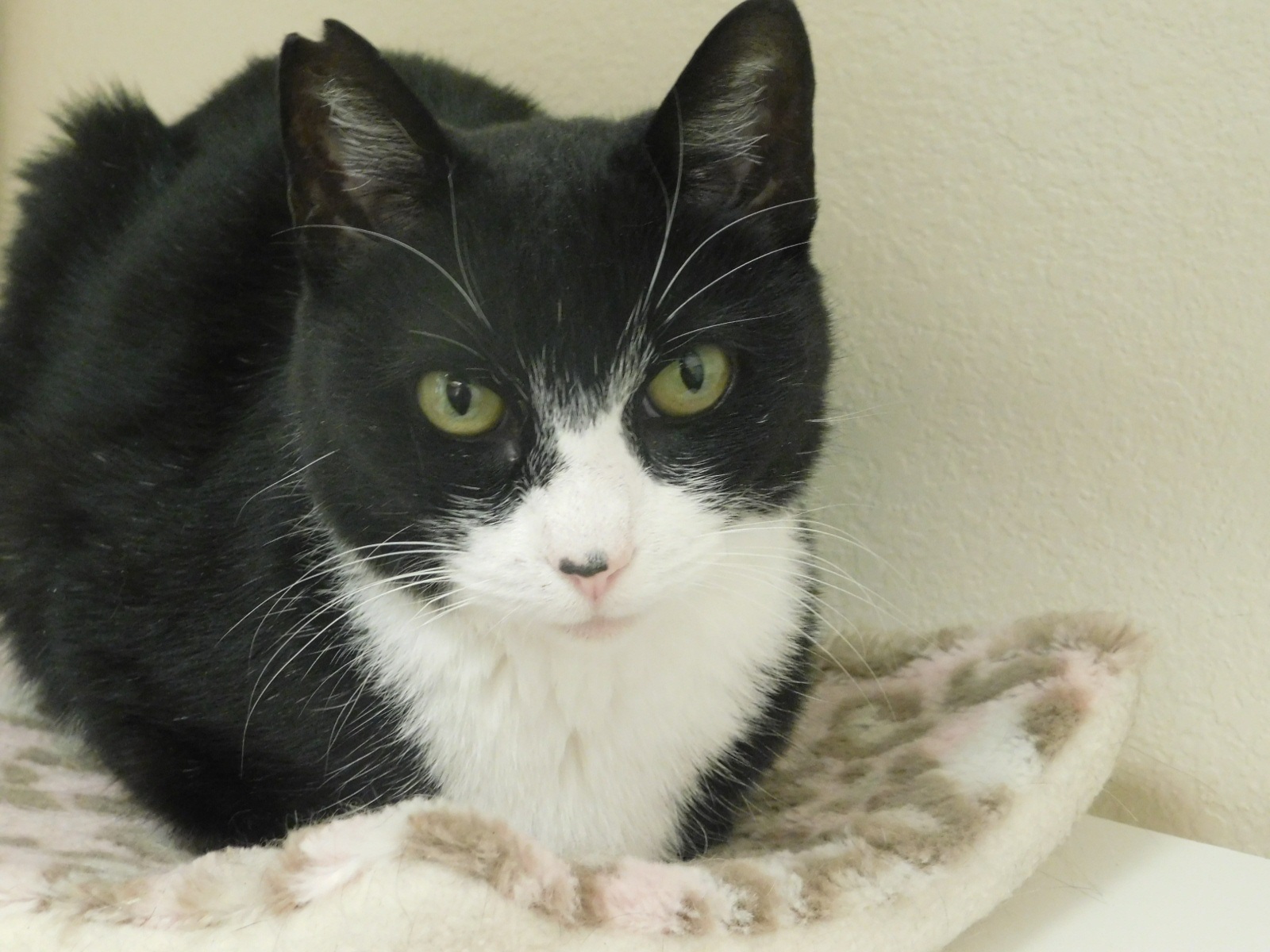
10 Jan Second Chance: Chatty Kitty
A new year.
A fresh start.
A new chapter in life waiting to be written.
New questions to be asked.
Answers to be discovered.
Although I speak chat, (pronounced “kat”), I understand many human words because I listen. To improve feline-human relations, I am going to help you to listen to and understand chat.

Panda
Many of my friends here at Second Chance are here because their people didn’t understand them. I write today in hopes of changing that sad situation.
Let’s start with the basics: there are six global chat sounds that domestic felines make to speak to our humans.
Our meow vocabulary uses different pitches, pronunciation and rhythms of the same basic sounds denoting different messages (and some breeds, like Siamese, even have their own distinctive meows). If you respond to your cat’s meows — like feeding them when they make a certain vocal demand — then that sound becomes tailored to you, because it produced results.
If your cat likes to hunt (rodents, socks, toys), you may know the “I caught it!” meow – the one that sounds a bit like a muffled moan when we display our captured prey, “Owwwww, Mowwwww” is used to celebrate our catch and show it off to our humans.
Another common “chat word” you’ll hear occurs when your cat is just being friendly, often when they jump on your lap or on the bed. It is our “Here I am!” greeting. This cat chortle is a birdlike, endearing sound, somewhere between a chirp and a purr. It has a bit of a vibration to it – like “Rrrrrrruh,” a sweet affectionate type of vocalization.
And then there is the growl. This low-pitched, menacing sound is a warning to be heeded. This wavering, growling “Grrrrow” noise is used toward other cats or dogs and lets you know we are feeling stressed. This is your cue to remove the stressor from our environment.
Although different cats have different ways of communicating impatience and hunger, common application is the increasingly loud and incessant “Meow! Meoww! Meowwww!” telling you to “Get off your lazy butt and feed me already!” The sound is also used for other demands such as to be let out. You will learn that the longer you ignore it, the louder and more insistent this meowing gets. Best to just comply immediately.
We all adore that high-pitched squeaky mew of a baby kitty, but it is good to note that if an adult cat lets out a strong, high-pitched meow, it is a screech, rather than a cute kitten squeak indicating the cat is upset about something.
And the sixth common vocalization is the quick, staccato “Meh!” or “Eh!” that seems to serve as a conversational filler or greeting. I like to use this when I approach people for affection or just want to have a chat. It is my way of saying “Hey there – how is your day going?”
Knowing these basic meows can also help with more serious communication, so you should take note if your cat’s meowing patterns change. This could indicate an illness, pain or other disturbance. An incessant meowing or a different kind of meowing may indicate it is time for a trip to the vet.
My name is Panda and I am a 1.5year-young talkative feline. I like to explore and be with people, but other cats make me rather nervous so I would prefer being the only cat in your life. My Panda-ness will be more than enough to keep any family feeling loved and protected. Although I find bamboo a bit too crunchy, I am partial to tuna wrapped in kibble.
Editor’s note: It’s no secret. The Telluride region is dog heaven. Well, pet heaven. Unless you are one of our furry friends who gets caught in the maw of neglect and abuse. Then heaven is on hold until Second Chance Humane Society comes to the rescue. Second Chance is the region’s nonprofit dedicated to saving animals’ lives and promoting responsible pet parenting and human-animal bond. In her weekly blog, executive director Kelly Goodin profiles at least one, generally two of the many animals now living at the no-kill shelter, Angel Ridge Shelter, a dog and a cat, hoping to find them loving permanent homes. The column is sponsored by Ted Hoff of Cottonwood Ranch & Kennel, who from time to time exercises his skills as a dog whisperer, partnering with Kelly and her staff to help train a particularly challenging animal.

Ted Hoff with Cabella & Wilbur
By the by, there is no better place to park your pup or get your pup (or adult dog) trained than Cottonwood whenever you head out of town (for locals) or are heading to town and staying somewhere that does not allow pets. Consider joining Ted’s Very Important Dog (VID) Club for added benies. (Details on Ted’s website.)
Second Chance Humane Society Animal Resource Center and Thrift Shop are both located in Ridgway, but service San Miguel, Ouray & Montrose Counties. Call the SCHS Helpline at 626-2273 to report a lost pet, learn about adopting a homeless pet, or about the SCHS Spay/Neuter, Volunteer, Feral Cat, or other Programs. View the shelter pets and services online: www.adoptmountainpets.org
Vetting the Vet: Dr. Michelle Dally, DVM, J.D. is Medical Director of Second Chance Humane Society. She also has a private practice, Dally Veterinary Medicine, 333 S. Elizabeth Street, Ridgway, Colorado. Her service area is San Miguel Mesas, Placerville, Ridgway, Ouray, and Montrose. For more on Dr. Dally, go here.

Michelle & Wallowby


Sorry, the comment form is closed at this time.